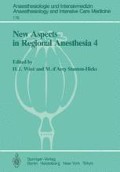Abstract
Relative cardiovascular stability has been found to be one of the major advantages of epidural anesthesia and, depending on the nature of the case, a moderate degree of hypotension may be tolerated before a correction becomes necessary. However, if the arterial pressure declines, it may be difficult to compensate for the dilated vascular bed resulting from sympathetic paralysis by means of fluid substitution alone. Impairment of circulatory compensatory mechanisms, activated by a decrease in perfusion pressure, may necessitate immediate treatment if the venous return is restricted by a loss of effective blood volume from hemorrhage or by postural pooling in regions of vasodilatation.
Access this chapter
Tax calculation will be finalised at checkout
Purchases are for personal use only
Preview
Unable to display preview. Download preview PDF.
References
Bergenwald L, Ecklund B, Kaijser L, Klingenström P (1972) Haemodynamic effects of dihydroergotamine during spinal anaesthesia in man. Acta Anaesth Scand 12:235–239
Bergmann H (1972) 20 Jahre Spinalanaesthesie, ein klinischer Erfahrungsbericht. Anaesthesist 21: 133–141
Bonica JJ, Kennedy WF, Akamatsu TJ, Gerbrrshagen H (1972) Circulatory effects of peridural block III. Effects of acute blood loss. Anesthesiology 36:219–227
Bromage PR (1978) Epidural Analgesia. Saunders, Philadelphia
Castenfors J, Lindblad LE, Mortasawi A (1975) Effects of dihydroergotamine on peripheral circulation during epidural anaesthesia in man. Acta Anaesth Scand 19:79–84
Clark BJ, Chu D, Aellig WH (1978) In: Berde B, Schild HO (eds) Ergot alkaloids and related compounds. Springer, Berlin Heidelberg New York, p 65 (Handbook of experimental pharmacology, vol 49)
Innes IR (1962) Identification of the smooth muscle excitatory receptors for ergot alkaloids. Br J Pharmacol Chemother 19:120–128
Kennedy WF Jr, Bonica JJ, Akamatsu TJ, Ward RJ, Martin WE, Grinstein A (1968) Cardiovascular and respiratory effects of subarachnoid block in the presence of acute blood loss. Anesthesiology 29:29–35
Mellander S, Nordenfelt I (1970) Comparative effects of dihydroergotamine and noradrenaline on resistance, exchange and capacitance function in the peripheral circulation. Clin Sci 39:183–201
Müller-Schweinitzer E, Stürmer E (1974) Investigations on the mode of action of ergotamine in the isolated femoral vein of the dog. Br J Pharmacol 51:441–446
Zimpfer M, Fitzal S, Tonczar L (1979) Aufhebung des Blutdruckabfalls bei Spinalanaesthesie durch Dihydroergotamin (DHE). Region Anaesth 2:43–47
Zimpfer M, Fitzal S, Ilias W, Raberger G, Stanek B (1980) Cardiovascular effects of dihydroergotamine in high epidural analgesia and mild acute hypovolemia. Region Anaesth 5:11–14
Zimpfer M, Schwarz M, Stanek B, Raberger G (1981) Cardiovascular effects of dihydroergotamine during epidural anaesthesia in dogs. Pharmacology 23:305–309
Editor information
Editors and Affiliations
Rights and permissions
Copyright information
© 1986 Springer-Verlag Berlin Heidelberg
About this paper
Cite this paper
Zimpfer, M. (1986). Hemodynamic Effects and Mechanism of Action of Dihydroergotamine in Epidural Anesthesia. In: Wüst, H.J., Stanton-Hicks, M.d. (eds) New Aspects in Regional Anesthesia 4. Anaesthesiologie und Intensivmedizin / Anaesthesiology and Intensive Care Medicine, vol 176. Springer, Berlin, Heidelberg. https://doi.org/10.1007/978-3-642-70807-7_15
Download citation
DOI: https://doi.org/10.1007/978-3-642-70807-7_15
Publisher Name: Springer, Berlin, Heidelberg
Print ISBN: 978-3-540-15938-4
Online ISBN: 978-3-642-70807-7
eBook Packages: Springer Book Archive

